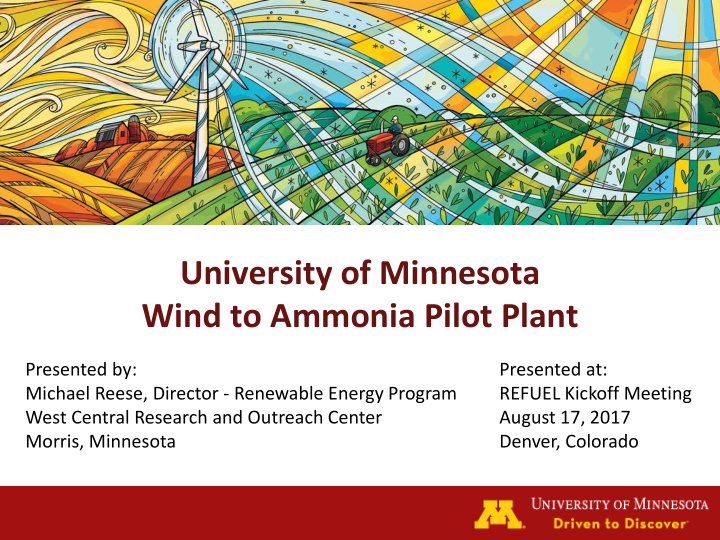



University of Minnesota Wind to Ammonia Pilot Plant Presented by: Presented at: Michael Reese, Director - Renewable Energy Program REFUEL Kickoff Meeting West Central Research and Outreach Center August 17, 2017 Morris, Minnesota Denver, Colorado
University of Minnesota West Central Research and Outreach Center 101 kW 1.65 MW solar PV Vestas V82 Wind Turbine NH3 Pilot Plant
Renewable Hydrogen and Ammonia Pilot Plant Hydrogen Storage Tanks Hydrogen, Nitrogen, and Ammonia Production Buildings Nitrogen Storage Tank Safety Equipment & Shower Building Ammonia Product Storage 12.5 kV to 480 V Transformer Ammonia Pump and Loadout (3000 Gallons)
Incoming gas Ammonia (NH 3 ) Process Flow N 2 H 2 820 ° F Separator Gas (N 2 & H 2 ) -15 ° F Condenser 1500 psi Recycle gas (N 2 & H 2 ) S-1 Electric NH 3 Heater -5 ° F Reactor 1500 psi NH 3 to Storage Chiller 250 psi -15 ° F 7.35 lb/h Compressor 50 ° F 930 ° F Gas 2000 psi (N 2 ,H 2 & NH 3 ) 180 ° F Process gasses & NH 3 are cooled Shell & Tube Heat Exchangers 800 ° F Process gasses are heated
Ammonia Reactor Skid
Safety Suggestions / Insights: • HAZOP review of designs and equipment • Hydrogen and ammonia safety training for staff (annual) • Set and follow Standard Operating Procedures (review and update as needed) • Safety meetings prior to startup, service, repair, etc. (e.g. catalyst) • Inspect and maintain safety equipment • Calibrate, inspect, and maintain sensors and alarms • Replace equipment, piping, tanks, etc. • Meet with local fire and emergency responders • Review all incidents (no matter how small) • There will be leaks and multiple detection methods will be necessary • Do not become complacent and make safety a high priority each day!
Troubleshooting Lessons Learned: 1. Viton does not work under high temperatures and pressures with mixed hydrogen, nitrogen, and anhydrous ammonia 2. Buna works for solenoid and flow control valves 3. Neoprene works for use as o-ring material
Troubleshooting Lessons Learn: 4. High temp sealants did not work on reactor plugs – plugs needed to be welded and re-stamped 5. Poly-carbonate glass can not be used
Troubleshooting Lessons Learn: 6. Ammonia is corrosive and hard on compressors 7. Other issues – Flow meter and sensor accuracy under extreme conditions 8. We continue to learn more each day and welcome questions!
Contact Information: Michael Reese, Director- Renewable Energy West Central Research & Outreach Center Phone: (320) 589-1711 Web: http://renewables.morris.umn.edu reesem@umn.edu University of Minnesota Collaborators: Alon McCormick , Professor* Ed Cussler , Professor* Joel Tallaksen , Scientist, WCROC Eric Buchanan , Scientist, WCROC Cory Marquart , Assistant Scientist, WCROC *Dept. of Chemical Engineering and Material Science Past funding provided by: • MN Corn Research & Promotion Council • U of MN IREE • U of MN MnDRIVE • MN Environment and Natural Resources Trust Fund • State of Minnesota
Recommend
More recommend